Source a range of images in which illustrators have created a sense of us and them or ‘otherness’. Read the images and identify how you think they have done this. Think about how they could have represented the subject differently, to avoid creating such a distance between them and the subject.
You may want to look at contemporary reportage illustration, historic examples or browse image archives.
Write a brief summary of your thoughts.
The first image I selected was The First Landing of Christopher Columbus (1862) by Dioscoro Puebla. It depicts the Italian explorer arriving on one of the islands in the Bahamas in 1492, which led to Columbus being credited with ‘discovering a new world’ and led the way for further expeditions into and the colonisation of what became known as America.
Looking at this image in terms of ‘otherness’, there were several key points that I noted:
- the Western explorers (or invaders?) are completely oblivious of the natives on the left of the composition. They appear to be solely interested in their achievement and the presence of religious individuals, along with the stances and eyes looking skywards of several of the Westerners suggest they believe ‘God has guided them to this holy place’.
- The natives seem to have been more of an afterthought for the artist as they fade into their surroundings and their features have not been as clearly defined as the newcomers. The red clothing of the individual in the centre, who I assume is Columbus, first draws the viewer’s eye, which then would scan to the right. So the composition is arranged so that the rest of the Westerners are seen before the viewer may then notice the natives on the far left.
- The two sets of people are also separated by the backgrounds, the native merging from the green foliage whilst the Westerners have the sea and their ship in the distance as their backdrop.
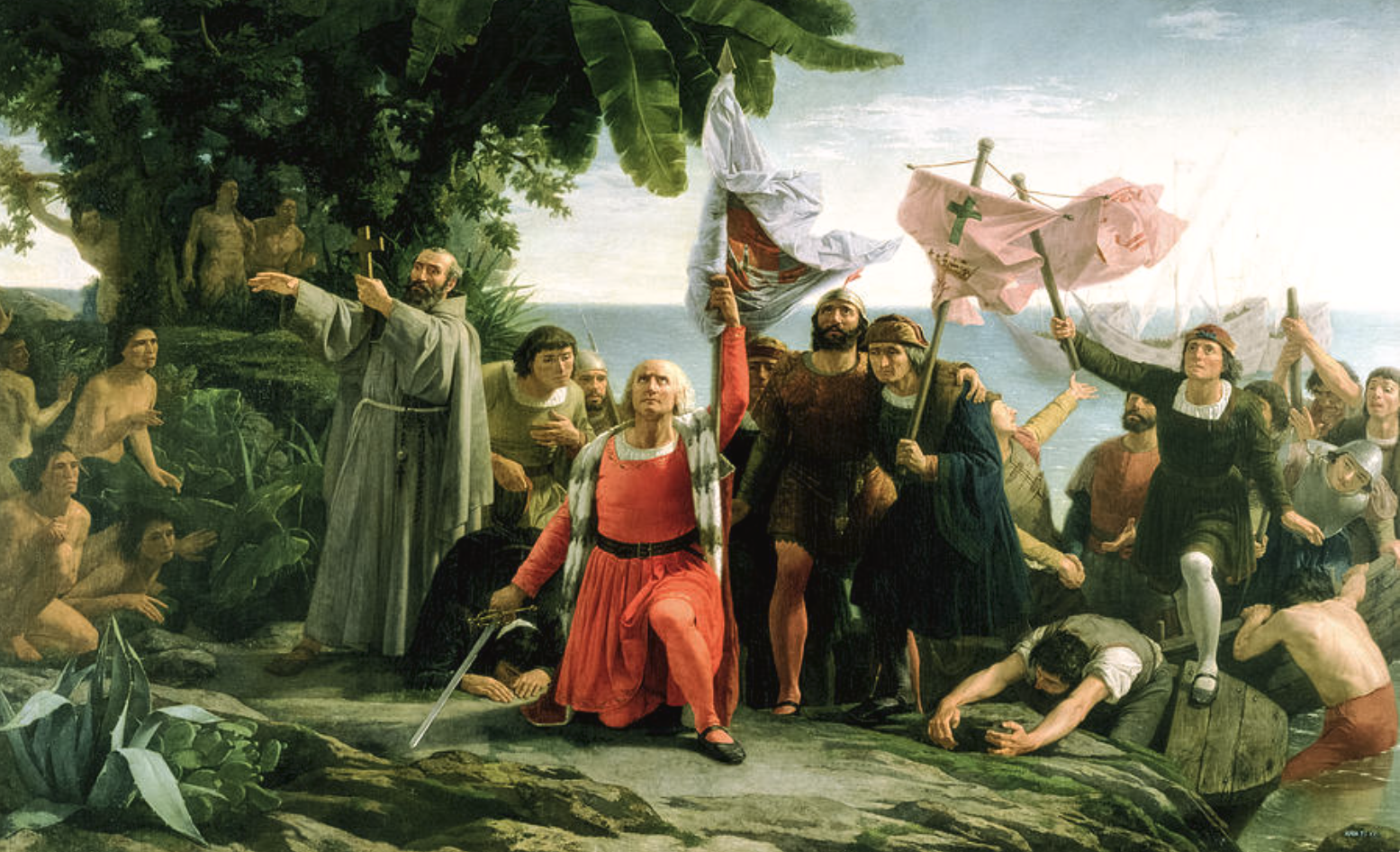
(Click on image for larger version, opens in new tab).
Source: Fine Art America.
I felt the caricature below about the colonisation of Africa from around 1900 was so offensive that it was quite a challenge to critique it rationally. I could not find any information regarding this image and its context, so my thoughts are based solely on thoughts.
The intention of ‘otherness’ is blatantly obvious in this image as the African man has been pinned to the ground by ropes and the white Europeans scurry over his body to secure him in place. I think perhaps the most insulting part of the image is the two men having a chat and leaning casually up against the man’s left calf. I believe that an intended message from this image is that the ‘wild black man has been controlled by the civilised white man’.
As a caricature, the image’s intention would have been seen as humour at a certain period of time, but this is not an excuse in my opinion.
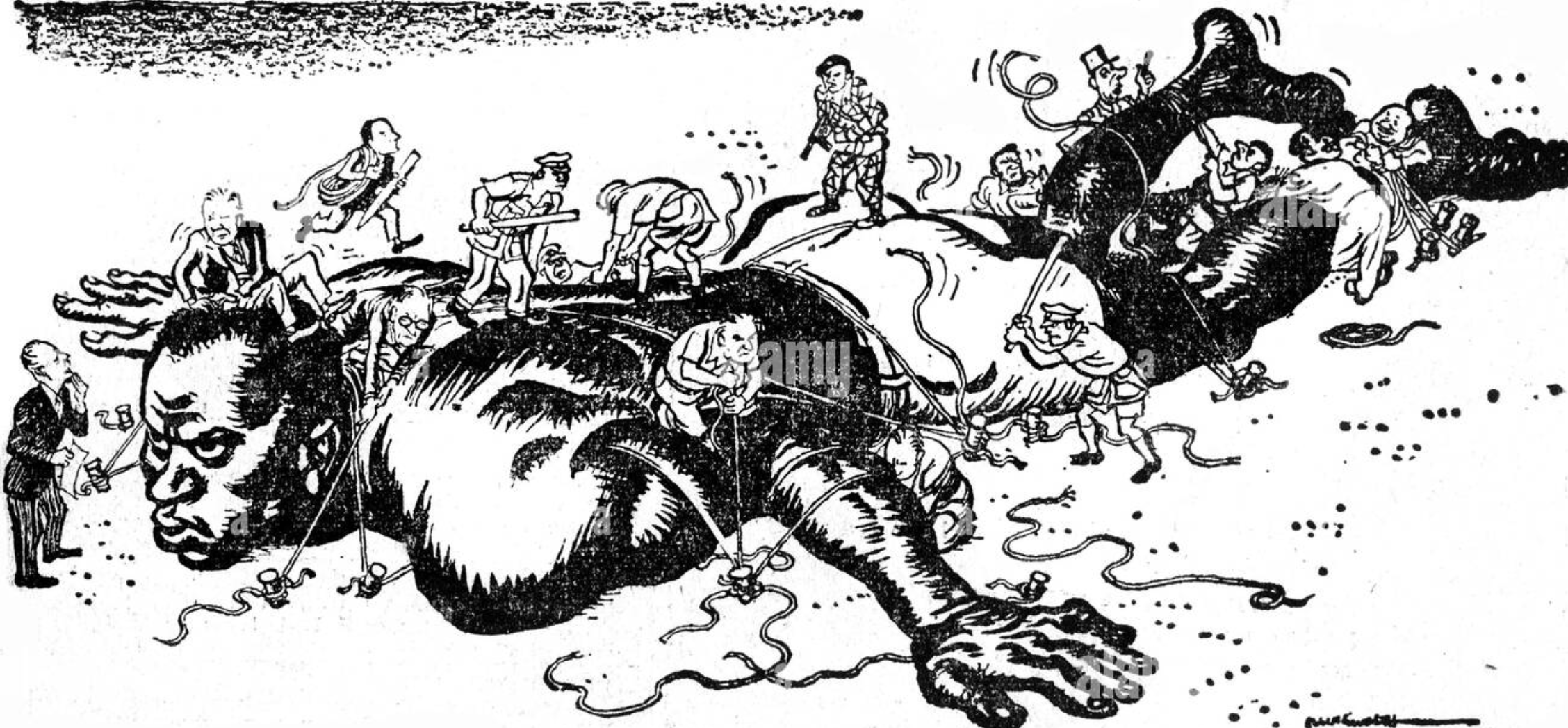
Source: Google Images.
The next painting I chose was by Benjamin Duterrau entitled The Conciliation (1840), which shows the Englishman Augustus Robinson trying to persuade Aboriginal resistance fighters to surrender in their efforts to protect Tasmania from the invading English, who wanted to ‘civilise’ and ‘Christianise’ the natives.
The title of the painting and handshake between Robinson and the native’s leader suggests that the former has been successful in his efforts and that ‘all is well’. However, the historian, curator and artist Dr Greg Lehman has pointed out that the native making the deal is not wearing his traditional necklace, as all the others are, and the man on the far right is indicating this to his fellow natives. I think this suggests they know they will be betrayed by the English, which they were.
Another key point I noted about this image was that, as with Puebla’s painting, the main focus is on the white man, Robinson, in the centre of the composition, with the Aboriginal group surrounding him. His white trousers and a glowing vignette that encircles him highlights Robinson as a kind of saviour figure – it looks like a religious piece of art
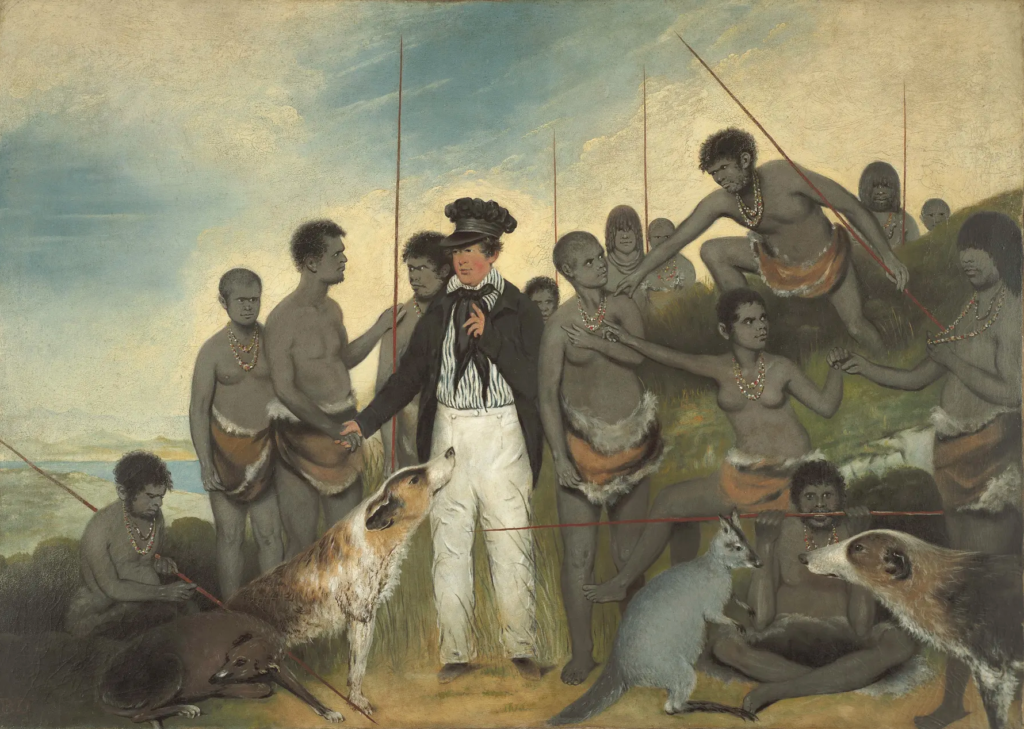
(Click on image for larger version, opens in new tab).
Source: Brewminate.
I felt that the previous three images showing ‘otherness’ could be considered artworks that demonstrated to me why sometimes it is important to find the context of the image and its intentions. They demonstrate how paintings/illustrations/images can be can be used to persuade people of a certain version of the truth for a particular purpose, in other words propaganda.
I do not think it would be possible to ‘rectify’ these without completely altering the idealised intention of the images. The more I thought about, in terms of colonisation, there would always be a sense of ‘otherness’ even If the viewpoint was from the indigenous people as they were being invaded – it was not a friendly, cohesive experience.
I then decided to select a few more images that I felt were relevant. I thought that these still suggest ‘otherness’, but in a more realistic and educational way.
The first image is How the West was Won (1982) by Donald Rodney. I thought this was a very clever painting as it seems to be mocking the deeply flawed, stereotypical belief of the ‘Wild West’. Rodney created this tone by painting in a very childlike style.
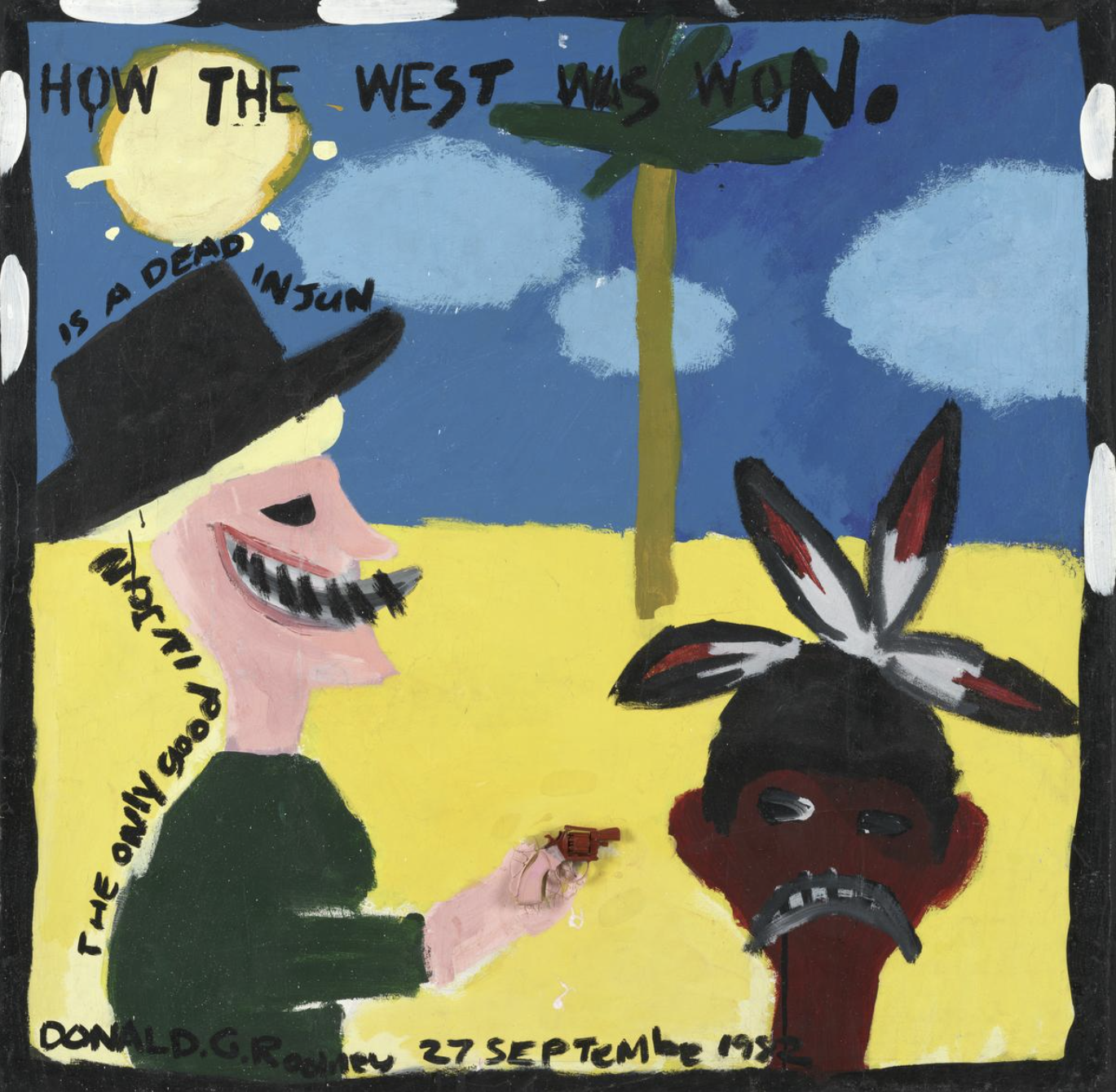
(Click on image for larger version, opens in new tab).
Source: Tate.
The book The Rabbits (1997) by John Marsden as illustrated by one of my favourite artists, Shaun Tan. It is based on a fictional colonisation, although taking into consideration the name of the book and that the author/illustrator are both Australian, I think it may be set in a fantasy version of that country. I liked that Tan has used metaphors to represent the events taking place and I felt the result is a set of very powerful images.
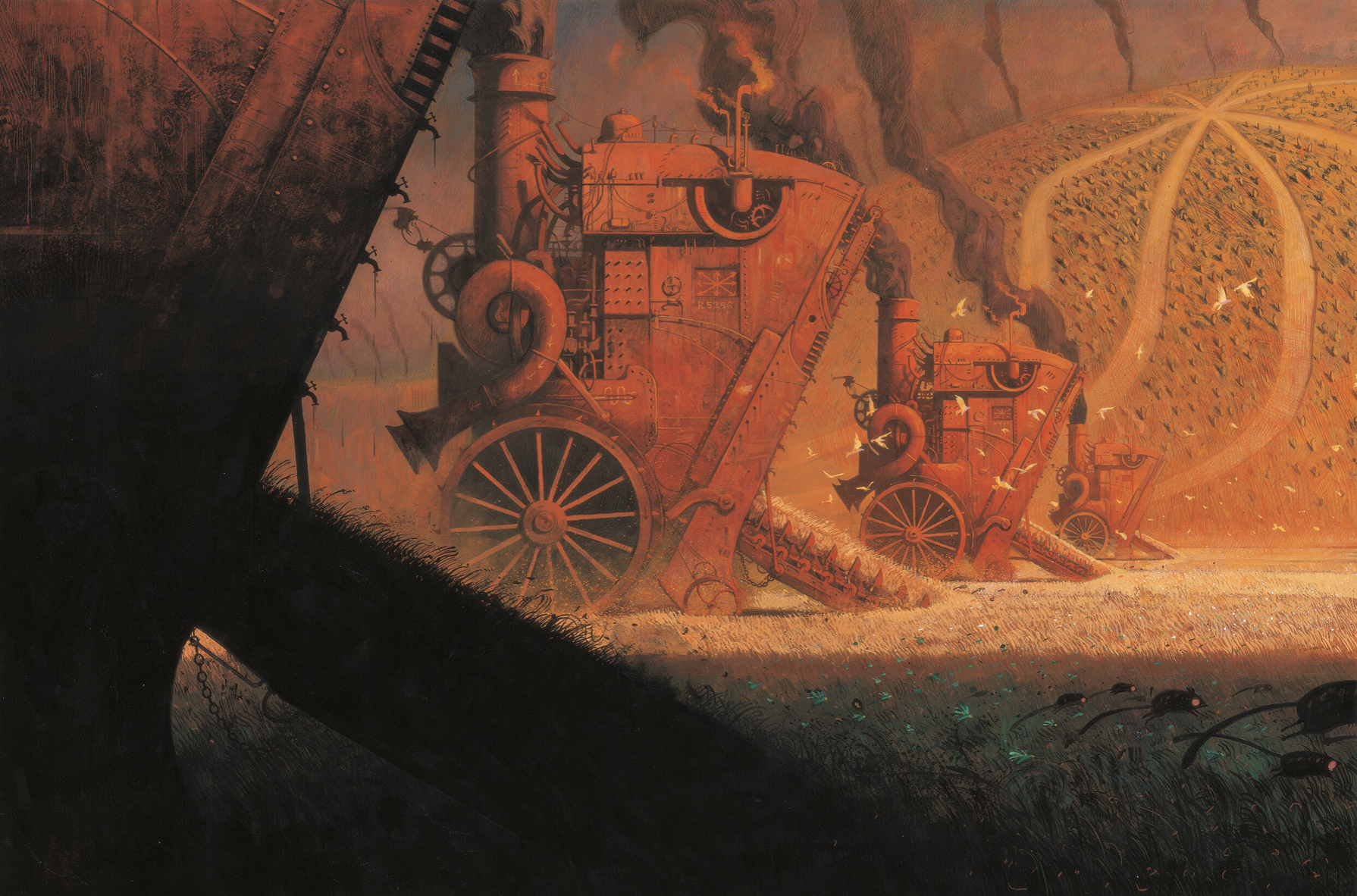
from The Rabbits written by John Marsden (1997).
(Click on image for larger version, opens in new tab).
Source: Shaun Tan.
The painting The Problem We All Live With (1963) by Norman Rockwell was his response to the six year old girl Ruby Bridges having to be escorted to school by four federal marshals to protect her from locals protesting against her presence there. I think although Rockwell was not African American himself he demonstrated how to produce a powerful image of an ‘other’ without being derogatory or disrespectful.
Rockwell based his image on meticulously researched reference photos and his efforts are clearly evident in this piece of work. I felt it was also important to note that Rockwell has ‘cut off the heads’ of the four white men and completely focused on Ruby, the complete opposite to previous examples discussed. He also dressed her in pure white – reinforcing her innocence as a child surrounded by such hatred.
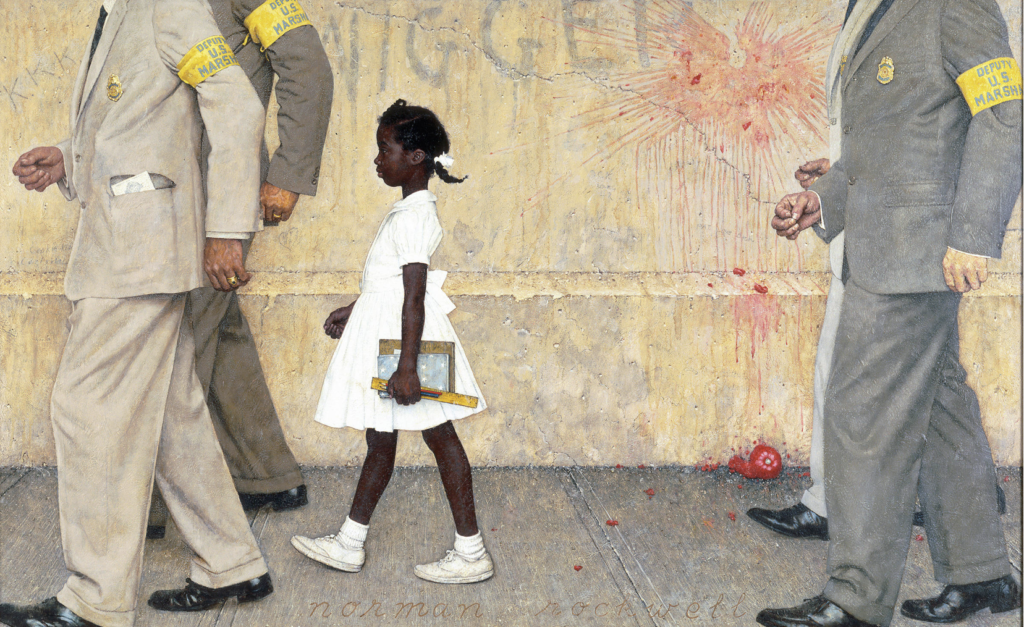
(Click on image for larger version, opens in new tab).
Source: The Kennedy Center.
The final image I selected is by the Cree artist Kent Monkman, ‘known for his thought-provoking interventions into Western European and American art history’. I thought Monkman’s works were excellent comparisons with those I found at the beginning of this research.
The title of the painting The Subjugation of Truth (2016) is powerful in itself before even looking at the artwork. There is a clear sense of ‘otherness’ in this image. The indigenous men are being restrained in the chairs with manacles around their ankles and one of them has the Mounty’s hand on his shoulder. They are facing sideways, not looking at anyone. Although they are in a terrible situation and several of the white men are gesticulating at them, Monkman has depicted the two as serene and majestic, steadfastly ignoring the men.
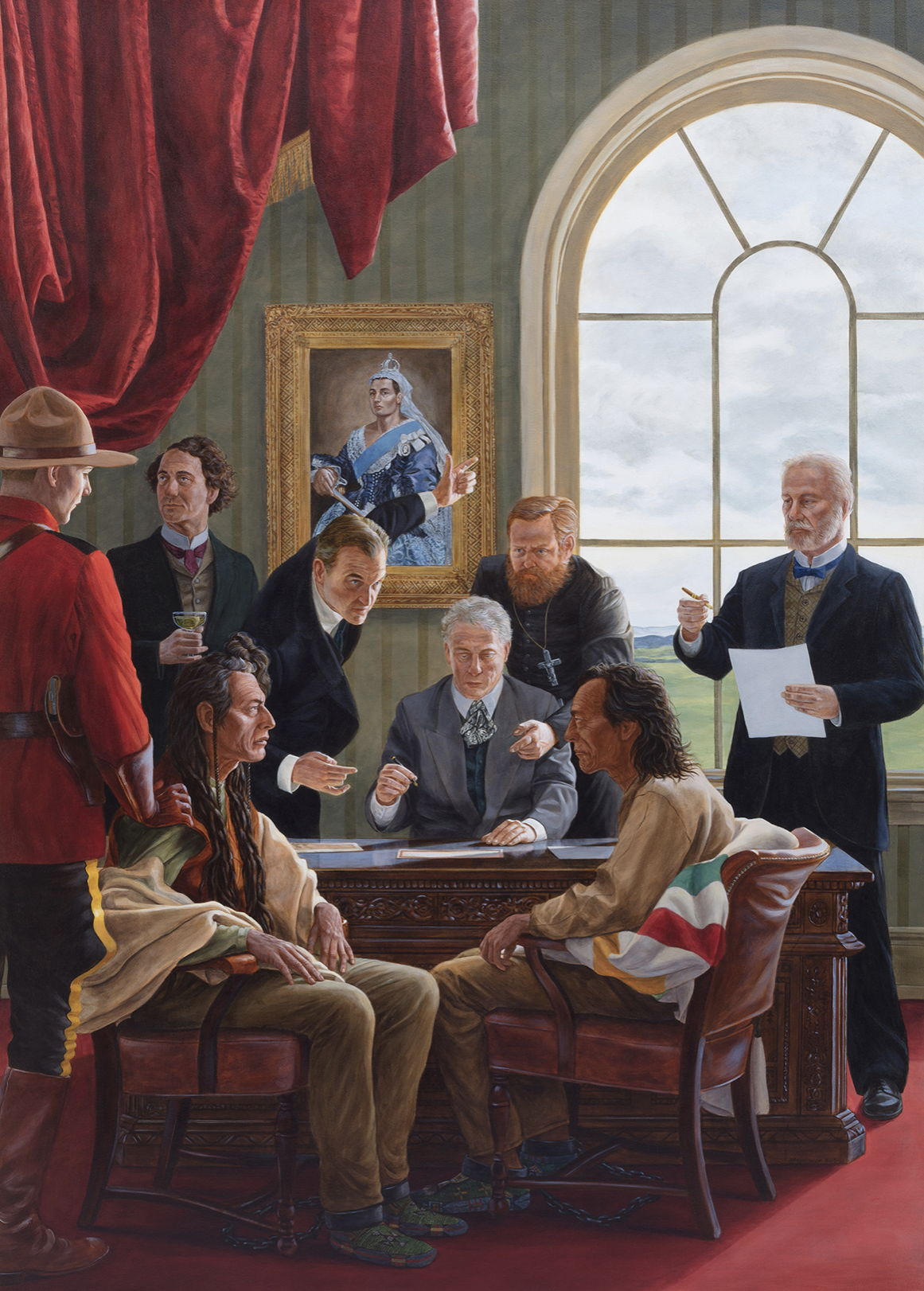
(Click on image for larger version, opens in new tab).
Source: Kent Monkman.
Final Thoughts
I am not sure if I was meant to focus solely on travel illustration for this Research Point, but ‘otherness’ is present in so many factors of society – such as gender, race, age and even, in my opinion, species – and so I found myself going off at a tangent slightly. I spent most of the time researching the images feeling angry about what I was seeing!
From my research I learnt that ‘otherness’ can be used in art/illustration as a tool for both positive and negative reasons. I therefore think it is important to consider ‘otherness’ as a way to criticise and raise awareness of injustices as long as it is done in a non-stereotypical, authentic and empathetic manner. It is important for the artist to be knowledgeable about the subject either via personal circumstances or through extensive research.
Bibliography
Clegg, H. and Gilchrist, S. (2014) Depictions of Aboriginal People in Colonial Australian Art: Settler and unsettling narratives in the works of Robert Dowling. Available at: https://www.ngv.vic.gov.au/essay/depictions-of-aboriginal-people-in-colonial-australian-art-settler-and-unsettling-narratives-in-the-works-of-robert-dowling/ (Accessed 27 February 2023).
Cyca, M (2017) Resistance 150: Indigenous artist challenge Canadians to reckon with our history. Available at: https://chatelaine.com/living/resistance-150-indigenous-artists/ (Accessed 27 February 2023).
Fine Art America (n.d.) The First Landing of Christopher Columbus by Dioscoro Teofilo Puebla Tolin. Available at: https://fineartamerica.com/featured/the-first-landing-of-christopher-columbus-dioscoro-teofilo-puebla-tolin.html (Accessed 27 February 2023).
Google Images (2023) Google Image Search. Available at: https://images.google.com (Accessed 27 February 2023).
Kiddle, R. (2020) Why colonisation is bad for everyone. Available at: https://www.stuff.co.nz/national/119963541/why-colonisation-is-bad-for-everyone (Accessed 27 February 2023).
Monkman, K. (n.d.) Kent Monkman. Available at: https://www.kentmonkman.com (Accessed 27 February 2023).
Morgan-Feir, C. (2017) Kent Monkman: History Painting for a Colonized Canada. Available https://canadianart.ca/features/kent-monkman-critiques-canada-150/ (Accessed 27 February 2023).
Pastan, A. (2022) Norman Rockwell + The Problem We All Live. Available at: https://www.kennedy-center.org/education/resources-for-educators/classroom-resources/media-and-interactives/media/visual-arts/norman-rockwell–the-problem-we-all-live-with/ (Accessed 27 February 2023).
Sooke, A. (2014) Kerry James Marshall: Challenging racism in art history. Available at: https://www.bbc.com/culture/article/20141023-i-show-black-is-beautiful (Accessed 27 February 2023).
Tan, S. (n.d.) Rabbits book – shaun tan. Available at: https://www.shauntan.net/rabbits-book (Accessed 27 February 2023).
Tate (n.d.) ‘Dancing Scene in the Caribbean’, Agostino Brunias, 1764-96. Available at: https://www.tate.org.uk/art/artworks/brunias-dancing-scene-in-the-caribbean-t13869 (Accessed 27 February 2023).
Tate (n.d.) ‘How the West was Won’, Donald Rodney, 1982‘. Available at: https://www.tate.org.uk/art/artworks/rodney-how-the-west-was-won-t12768 (Accessed 27 February 2023).
Trounson, A. (2019) Colonial Australian Art: Helping Us to See When We Don’t Want to Look. Available at: https://brewminate.com/colonial-australian-art-helping-us-to-see-when-we-dont-want-to-look/ (Accessed 27 February 2023).